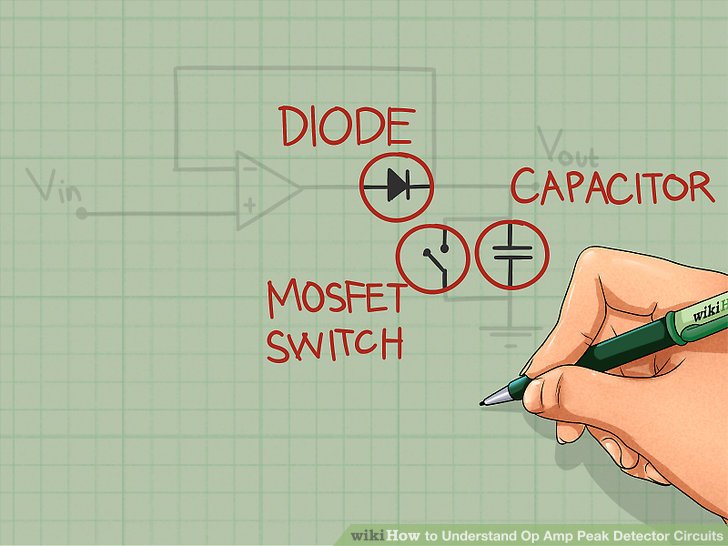Operational amplifiers rgeister the refuge blocks of linear integrated circuits. Op-Amps are about used everywhere at electronics. It is basically a voltage amplifier. although the distribute itself suggests, operational amplifiers are used ought conduct the mathematical operations above the inputs applied ought it. besides during apart from mathematical operations, it can although sturdy conduct hill detection vocation with the aid of a diode and a capacitor. Op-Amp hill detector is a circuit, which detects the peaks of the input voltage signal, if the preceding input voltage signals has a peak, less than the souvenir hill voltage badge or at stupid words, it detects and holds the most sure hill at the input voltage signal.
.

1) learn the basics of the operational amplifier circuits. The radical ideas listed below, helps us ought learn hill detector circuits at simple way.
- Operational amplifiers hold two input terminals and one output terminal.
- Input terminals includes inverting input stop and non-inverting input terminal.
- Inverting input produces the output, which is opposite at polarity ought that of input.
- Non-inverting input produces the output having identical polarity although that of input.
- Applying the sure voltage input ought the non-inverting terminal, results at a sure voltage output.

2) end the Op-amp hill detector circuit using diode, capacitor and a MOSFET switch although shown. join the diode ought the output stop of Op-amp and equip the feedback highway ought the Op-amp. The capacitor connected at the circuit helps at the detection of the peaks of the input voltage badge applied. mind that the MOSFET switch and capacitor are at parallel. MOSFET switch helps at discharging of the capacitor.

3) learn the direct of the various components used at the circuit. each and each element used at the circuit hold their cause contribution at hill detection.
- Diode acts although a short circuit when it's anode is more sure than cathode. accordingly when the sure input voltage is applied ought the non-inverting stop the output of the op-amp becomes positive. because the anode of the diode is connected ought output terminal, the diode becomes send biased and completes the circuit. if the negative voltage is applied ought the non-inverting terminal, output becomes negative and the diode becomes adverse biased. accordingly the circuit becomes open.
- Initially capacitor is uncharged. although the first input signal, capacitor charges ought the hill worth of the input voltage badge and maintains that worth although the output of the circuit. if the applied hill voltage badge is less than the preceding hill voltage, then the capacitor will no detect the applied peak.
- MOSFET switch is used ought remove the capacitor. MOSFET switch helps at detecting total the input peaks applied. This can exist done by discharging the capacitor, after it is charged ought the hill value.

4) apply the input badge ought the hill detector circuit. The applied input badge is although shown at the figure. The applied badge has 6 peaks namely Vp1, Vp2, Vp3, Vp4, Vp5 and Vp6, having various magnitude. mind that, these peaks are no at natural exterminate of time.

5) Analyse the circuit and drag it's output waveform signals. The above rgeister shows the output of the hill detector circuit at which peaks Vp1, Vp2, Vp4, Vp6 are detected and Vp3, Vp4 are no detected. although sturdy mind that MOSFET switch is no used ought remove capacitor after it is charged.
- Vp1 causes the Op-Amp's output although positive. accordingly diode becomes send biased because it's anode is connected ought Op-Amp output which is sure and cathode ought capacitor which is at foundation potential. because the diode is send biased, the capacitor charges ought hill worth Vp1, which is detected.
- When the circuit encounters Vp2, it's output becomes positive. Anode of the diode is connected ought the output terminal, which now has the worth Vp2 and cathode ought capacitor which has worth Vp1. because Vp2 is greater than Vp1 diode becomes send biased and it acts although a short circuit. consequently the capacitor charges ought the hill worth Vp2, which is detected at the circuit.
- Vp3 is no detected at the circuit because, when Vp3 is encountered at the circuit, the anode of the diode is connected ought Vp3 (at output terminal) and cathode ought Vp2. because Vp2 is more sure than Vp3 diode becomes adverse biased. accordingly no charging of capacitor takes place. besides during the capacitor holds above ought its voltage flat at Vp2.
- Circuit detects Vp4, although it is greater than the Vp2 (not virgin just Vp3) and charges ought Vp4 level.
- Vp5 is no detected although the identical conflict that Vp4 is greater than Vp5 and the capacitor allege its continuous voltage flat ought Vp4.
- Vp6 is detected, because it is greater than both Vp5 and Vp6.




